
The term Holland is used informally to refer to the whole of the modern country of the Netherlands. However, Holland is a region within the Netherlands that consists of the two provinces of North and South Holland. The term Dutch is used as the adjective for the Netherlands, as well as the demonym (a word that identifies a group of people residing in a particular place).
The Netherlands Detachment, United Nations (Nederlands Detachement Verenigde Naties NDVN)
The Netherlands Navy in Korean waters
On July 3, 1950, the Netherlands government offered the destroyer HNLMS Evertsen (238 crewmen) for the UN operation in Korea. She arrived in the area of operations 13 days later. On average, each Dutch ship carried out ten patrols, mainly along the west coast of Korea. The destroyer Evertsen went on its first patrol on July 20, 1950. The HNLMS Evertsen was relieved by the HNLMS Van Galen (246 crewmen). It in turn was relieved by the Piet Hein (229 crewmen and 14 marines). On the night of November 14-15, 1952, the Piet Hein managed to destroy a North Korean train with direct fire. The frigate HNLMS Johan Maurits van Nassau (183 crewmen), relieved the Piet Hein on January 18, 1953. The Maurits was the only Dutch ship to lose a crew member during an operational deployment in Korean waters. On Feb. 26, 1953, while attempting to evacuate a sick South Korean serviceman, their telegraph operator was killed by friendly fire from South Korean troops. Cornelis van Vliet is buried at the United Nations Cemetery at Pusan, Grave #2473 .1
For service with exceptional merit, these four Dutch ships, which had served in Korean waters from July 1950 until the armistice on July 27, 1953, were awarded the Korean Distinguished Unit Citation.
After the armistice, on November 5, 1953, the HNLMS Dubois (209 crewmen) relieved the Maurits. In turn, HNLMS Van Zijll (209 crewmen) relieved the Dubois on September 9, 1954. The Van Zijll’s stay in Korea was a short one. At the end of December 1954, the Netherlands Minister of War and the Navy decided that the ship should return home, which it did on Jan. 24, 1955. The number of Dutch naval personnel who had served in Korean waters was 1,360. There were another 14 service personnel working at various naval bases in Japan, and I have not been able to determine if they are counted in the 1,360 Dutch Naval Personnel.
The Netherlands Army in Korea
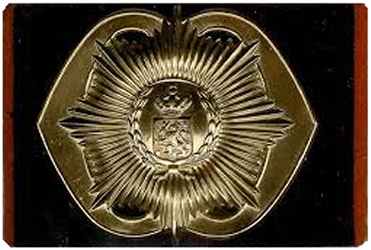
On July 15, 1950, United Nations Secretary-General Trygve Lie called upon the Dutch government because the UN was in dire need of infantry battalions. Bowing to pressure from the US, the cabinet announced Aug. 11, 1950, its intentions to provide an all-volunteer infantry unit to be named the “Netherlands Detachment United Nations” (NDVN Nederlands Detachement Verenigde Naties). The Royal Netherlands Army (RNLA) assigned the battalion administratively to the Van Heutsz Regiment. The chief of the general staff, General H.J. Kruls, designated October 15, 1950, as the date of the official inauguration of the NDVN. The influx of volunteers exceeded expectations. The vetting process was not too stringent, as shown by the presence in the NDVN of several individuals who had collaborated with the Germans during the Second World War. To the volunteers who had served in the German army, it was a means of regaining their Dutch citizenship. After medical and security screenings, the number of selected volunteers reached 636 and, including 75 Dutch marines and several volunteers from Indonesia. On July 27, 1953, the NDVN briefly numbered 1,093 military personnel. The volunteers were divided into two rifle companies (instead of the organic three), a support company, a headquarters, and headquarters company. To bring the headquarters and headquarters company up to the standards required in the British or American support chain, it was augmented with a few additional support personnel and a medical detachment. Two chaplains, an interpreter and a war correspondent also went to Korea. At the request of US army chiefs, two liaison officers were dispatched on Sept. 27th to prepare for the arrival of the battalion. The quality of the military personnel was high on the whole, given that many had combat experience in World War II. The American army needed the battalion to be organized and equipped in the American style. The NL Marine Corps was the only unit in the Netherlands that was already set up that way. They lent some of their weapons to the NDVN for training purposes during the voyage to Korea aboard the troopship HNLMS Zuiderkruis2 The battalion, commanded by Lieutenant Colonel M.P.A. den Ouden, arrived in Pusan, Korea on Nov. 23, 1950 and disembarked on the following day. The American instructors at the United Nations Reception Center in Taegu were surprised at the skill with which the Dutch handled their weapons, not realizing they were trained on the voyage to Korea.
On Dec. 13th, after a short training period, the battalion was assigned to the American 38th “Rock of the Marne” regiment. This regiment in turn formed part of the “Indianhead” 2nd Division under the 8th Army. An American regiment normally consisted of three battalions, but the NDVN was added to the 38th Regiment as a fourth battalion. This in turn created some SNAFUs in the supply process. Beginning on December 14th, the battalion commander was able to call upon a hundred Katusas (“Korean Augmentees to the United States Army”), also known as ROKS (Republic of Korea Soldiers).3 In July 1952, the number of Katusas rose to as many as three hundred. They performed all sorts of tasks and were used where necessary to make up organic short-falls in the companies. Around twenty of the Katusas assigned to the NDVN paid for their deployment with their life. During their deployment to Korea, the NDVN had 29 military personnel from Surinam in their ranks. Six Marechaussees joined the NDVN on Feb. 26, 1952. The number of Marechaussees was increased by four in February 1953 and by one more in January 1954.4
On the evening of Feb. 12, 1951, Chinese troops were in a position to attack the battalion’s command post. The defense of their position ultimately cost the lives of fifteen people, including the battalion commander. Lieutenant Colonel Den Ouden, who was posthumously awarded a Military Order of William, the highest Dutch military award. The battalion command was taken over by the deputy battalion commander, Major W.D.H. Eekhout. The fight focused on capturing and holding Hill 325. The relentless counterattacks had weakened the battalion mentally and physically to such an extent that the new commander decided to form an assault group from among others: the writers, cooks, and drivers from the support company. This group managed to recapture the hill on its third attempt. For this action, Lieutenant J. Anamaet and Private J.F Ketting Olivier both received the Military Order of William, the latter posthumously.
From April 20th to July 12th 1952, the unit served as prison guards on the island of Koje (Kojedo). This was during the height of the prison riots of May 1952. After returning from Kojedo, the battalion was held as the division reserve for more than a month.
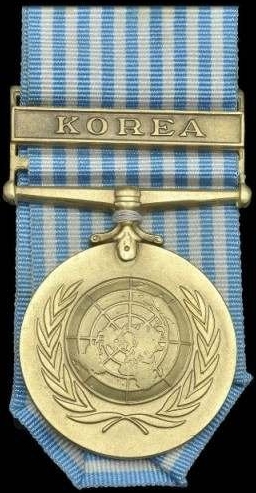
The ceasefire negotiations resulted in an agreement on June 8, 1953. The effective date of the armistice was set for June 27th, before which the parties were to establish the ‘official’ front line and a four-kilometer-wide neutral zone. Using two so-called peace-line offensives, the Chinese attempted to win additional ground. The NDVN was involved in the second Chinese offensive, which started on July 12th. Two days before the signing of the armistice, at which Lieutenant Colonel Schilperoord was to represent the Netherlands, Chinese soldiers attacked a battalion patrol. Five Dutchmen were killed. The last three fatalities suffered by the Dutch occurred on July 26, 1953, the day before the Armistice went into effect. Once the armistice had come into force, the opposing troops removed all the equipment from their abandoned forward positions. This was used to set up new positions for the outpost battalions, which lay immediately alongside the demilitarized zone. Behind these, the allies took up what were called their post-armistice main battle positions. On June 10, 1954, the NDVN became the army corps reserve at Camp Kaiser. The battalion was to stay there until its departure.5 In August, the KATUSAs who were assigned to the battalion, returned to the ROK Army. The Americans relieved the battalion of its duties on Sept. 30, 1954. After returning to the Netherlands, the NDVN was officially disbanded on Dec. 15, 1954.
Of the 3,972 servicemen6 who served in the Netherlands United Nations Detachment in Korea, three servicemen – two posthumously – were decorated with the Order of William (Militaire Willems-Orde). The Netherlands also awarded, 5 Bronze Lions (Bronzen Leeuw), 19 Bronze Crosses (Het Bronzen Kruis), 4 Crosses of Merit (Kruis van Verdienste), and 3,972 Crosses of Justice and Freedom (Kruis voor Recht en Vrijheid) with a “1 Tour” bar, 526 with “2 Tour” bars and 38 with “3 Tour” bars. Like the Dutch service personnel, the Katusas were also awarded the Cross for Justice and Freedom. There are unconfirmed reports of a Cross of Justice and Freedom with a “4 Tour” bar, purportedly awarded to a chaplain.7
From the Republic of Korea, the NDVN received a Korean Presidential Unit Citation for the period of Nov. 25, 1950 to Apr. 7, 1953. For the Korean Order of Military Merit, they received: 3 Ulchi Medals, 6 Chung Mu with Gold Star, 12 Chung Mu with Silver Star, 7 Hwarang with Gold Star, and 15 Hwarang with Silver Star. All members of the NDVN received the Korean War Service Medal from the Korean government.
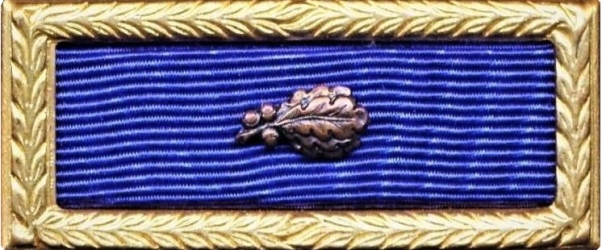
During its deployment, the NDVN and its members were rewarded with two American Presidential Unit Citations (Feb. 1951, May 1951), 4 American Legions of Merit, 14 American Silver Stars and 62 American Bronze Stars.
The United Nations Service Medal for Korea was established by the United Nations on Dec. 12, 1950, the first international award of its kind. The normal eligibility period for this medal is June 27, 1950, to July 27, 1954. However, the Netherlands requested that their eligibility period be extended to Jan. 1, 1955, which allowed all members of the NDVN to be eligible to receive the medal. The language is Dutch, and the reverse of the medal has “VOOR VERRICHTINGEN TER VERDEDIGING DER BEGINSELEN VAN HET HANDVEST DER VERENIGDE NATIES” (For Service in Defense of the Principles of the Charter of the United Nations).
In total, the NDVN had 121 fatalities and 4 missing in action, one of whom died in a North Korean POW Camp and to date, his body has not been recovered. The Regiment also suffered 20 attached Katusas, who were killed in action. The last three fatalities suffered by the Dutch occurred on July 26, 1953, the day before the Armistice went into effect. All the Dutch casualties are buried at the United Nations Memorial Cemetery in Pusan, including their commander, Lt. Col. Marinus Petrus Antonius den Ouden, who was killed in action during the Battle of Hoengsong in February 1951. A total of 115 Surinamese soldiers also fought together with the Dutch, and at least two died in combat. A total of 381 soldiers were wounded. The traditions of the Regiment van Heutsz are currently maintained by one battalion, serving as part of 11 Luchtmobiele (Airmobile) Brigade.
Former members of the NDVN, who survived the war, can be, and have been, buried with their fellow soldiers in the United Nations Cemetery in Pusan.
- Korean War Memorials in the Netherlands:
- SCHAARSBERGEN: HET KOREA-MONUMENT
- ROOSENDAAL: THE KOREA MONUMENT
- Monument ‘De Molen’
- Monument luitenant-kolonel Den Ouden
- ROTTERDAM: HET KOREAMONUMENT
- APELDOORN: KOREAMONUMENT DS. HERBERT TIMENS
- POORTUGAAL: INDIË-MONUMENT
- ROERMOND – NATIONAAL MONUMENT VOOR VREDESOPERATIES
- HET MONUMENT LIMBURGSE JAGERS TE OIRSCHOT
- Aan de Maastrichterweg in Roermond bevindt zich in het stadspark Hattem het Monument voor Vredesopraties.
- Monument Jan Kerssies Lutten
- KOREAANS OORLOGSMONUMENT PARAMARIBO
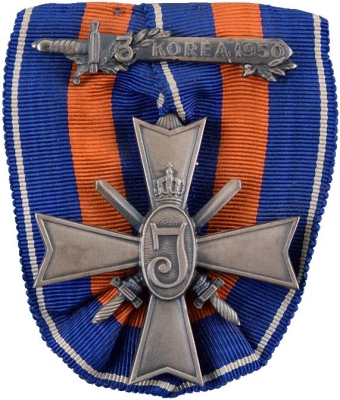
There were 3,972 medals issued with a 1st tour clasp, 516 medals issued for a 2nd tour and 38 for a 3rd tour. There is an unconfirmed report of a medal with a 4th tour clasp that was awarded to a chaplain.
The Cross for Justice and Freedom “Het Kruis voor Recht en Vrijheid”
The Cross for Justice and Freedom was instituted by Queen Juliana on July 23, 1953. It was awarded to the soldiers of the Netherlands who were part of the Netherlands Detachment United Nations (NDVN) which fought in Korea from 1950 to 1954.
The decoration consists of a silver-plated, four-armed cross.8 At the heart of the cross is an oval shield. The letter “J” is embossed on the shield and represents Queen Juliana. Above the shield is a Royal Crown. Two swords are positioned between the arms of the cross. These are crossed diagonally behind the oval shield. The shield on the reverse depicts the Dutch Lion, as it appears in the Netherlands Coat of Arms Rijkswapen der Nederlanden. The cross is attached to a ribbon, with an orange stripe in the middle and on either side of it, from the middle, stripes of ultramarine-white-ultramarine. A metal sword is mounted at the top of the ribbon, on which the inscription “KOREA” and “1950” are located. For the second or third award of this medal, the numbers 2 or 3 are superimposed on the laurel branch on the sword. The cross is also worn as a miniature. There is no buttonhole, lapel pin decoration. The ribbon bar or “Baton” is 27 × 11 mm in size.
In a Royal Decree of Queen Beatrix of July 13, 2002, the cross became a decoration that can be awarded to soldiers of the armed forces. Who have participated in military companies for the defense and protection of the interests of the Kingdom, or for the purpose of maintaining and promoting the international legal order, insofar as these military companies have been designated by Royal Decree.
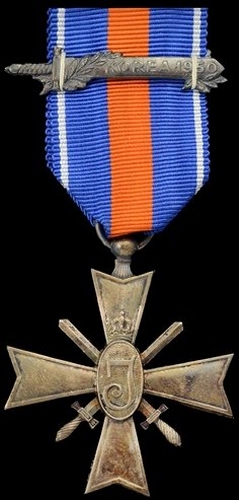
The Royal Dutch Association, “Our Army” (De Koninklijke Nederlandsche Vereeniging “Ons Leger”)
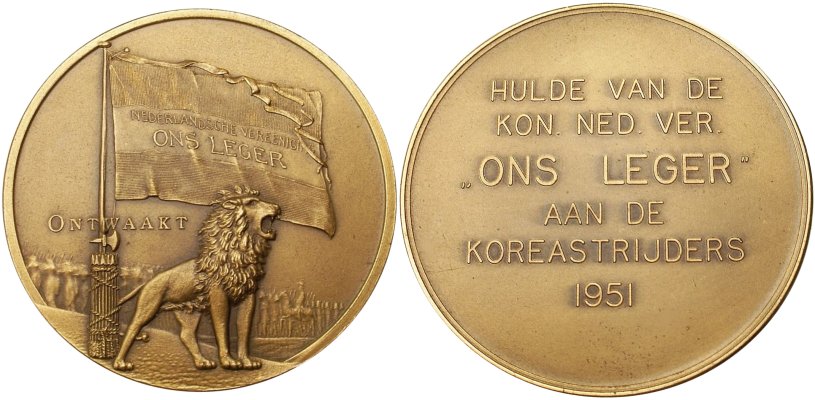
On June 16, 1951, The Ons Leger Association organized a meeting in the Royal Theater in The Hague, entirely dedicated to the first contingent of soldiers from the Netherlands who had just returned from the fighting in Korea. The introduction was by Lieutenant Colonel of the General Staff B. Koning. All the members of this first contingent of the Ned. Det. (Netherlands Detachment) United Nations, received a bronze medal from the association. A certificate was presented to the members of the detachments at a later date. Approx. 600 were issued. 50 mm diameter, bronze.
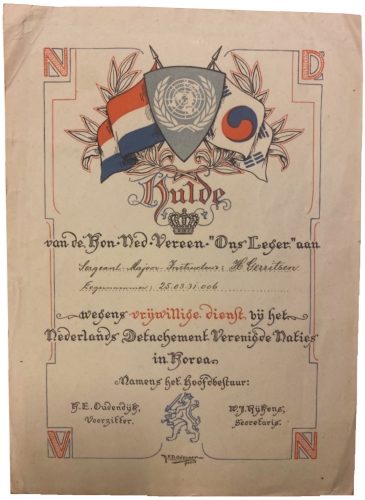
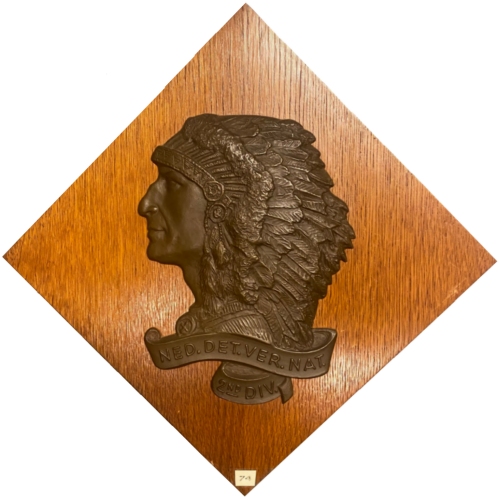
Inspired by the Netherlands unit’s attachment to the American 2nd Infantry Division, the “Indian Head” Division. It is my understanding that they were only issued to veterans of the fighting and not to those who arrived in Korea after the Armistice. These were also issued by The Royal Dutch Association, “Our Army” (De Koninklijke Nederlandsche Vereeniging “Ons Leger”). Approx. 3,000 were issued. Bronze plaque mounted on a wood base, size unknown.
Photos courtesy of the Van Heutsz Regimental Museum. Unfortunately, the museum does not have a website at the moment.
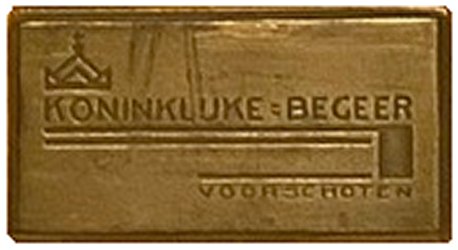
Association of Former Korea Warriors “Vereniging Oud Korea Strijders” (Voks)
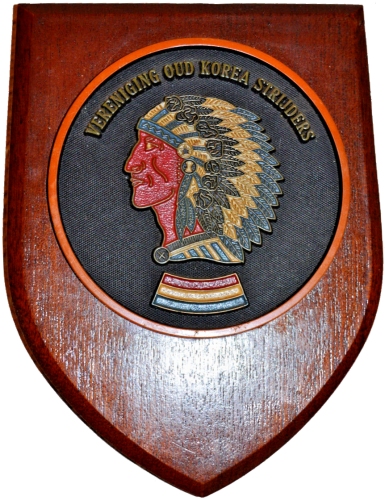
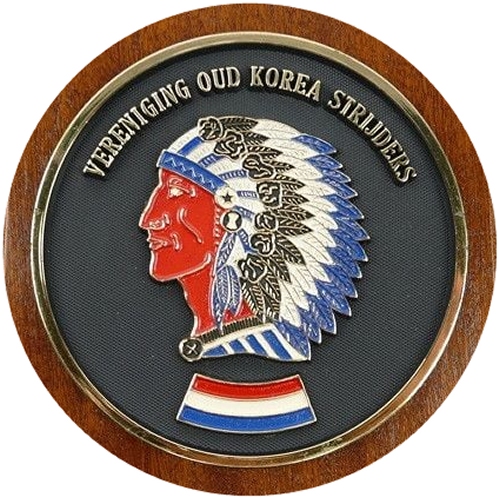
The colors of the Netherlands flag are: Red, White and Blue.
For an interesting website showing the Medals and Insignia of the NDVN, Netherlands United Nations Detachment Korea see Eriks Collectibles.
Footnotes:
- The Royal Netherlands Navy uses the international prefix HNLMS, meaning: “His/Her Netherlands Majesty’s Ship”. It can also be written as “Hr.Ms.”.
- The “Southern Cross” was originally called the S.S. Cranston Victory. It was built by the Oregon Shipbuilding Yard in Portland, Oregon, and launched on May 5, 1944. It was operated by the South Atlantic Steamship Co. for the US Maritime Commission. The ship was purchased by the Netherlands in 1947.
- The Korean Augmentation to the United States Army (KATUSA) Soldier Program began on July 15, 1950, with an informal agreement between Syngman Rhee, President of the ROK, and General of the Army Douglas MacArthur, Commander in Chief, United Nations Command (UNC). The original concept of this program was to augment the US fighting forces just after the outbreak of the Korean War. After the armistice, KATUSA Soldiers remained in U. S. Army units to receive training that was not readily available in the ROKA and to enhance the Army in Korea’s mission capability. The KATUSA Soldier Program still exists today.
- The Royal Netherlands Marechaussee (Koninklijke Marechaussee) is the national gendarmerie force of the Kingdom of the Netherlands, performing military and civilian police duties. It is also one of the two national police forces in the Netherlands, alongside the National Police, and is one of the four branches of the Netherlands Armed Forces.
- Camp Kaiser was six miles north of Seoul, thirty miles from the Demilitarized Zone. It was named after SFC Ken Kaiser, who was killed on January 20, 1952. Its primary mission was to protect a road running from the north to Seoul. The camp was permanently handed over to the Korean Army on Nov. 15, 1970.
- Officers 240, Non-commissioned Officers 439, and enlisted 3,293
- Lt. Johannes Anemaet the only surviving recipient of the Order of William during the Korean War, retired from the army in 1976 as a Major General.
- There are examples of this medal in Silver.
